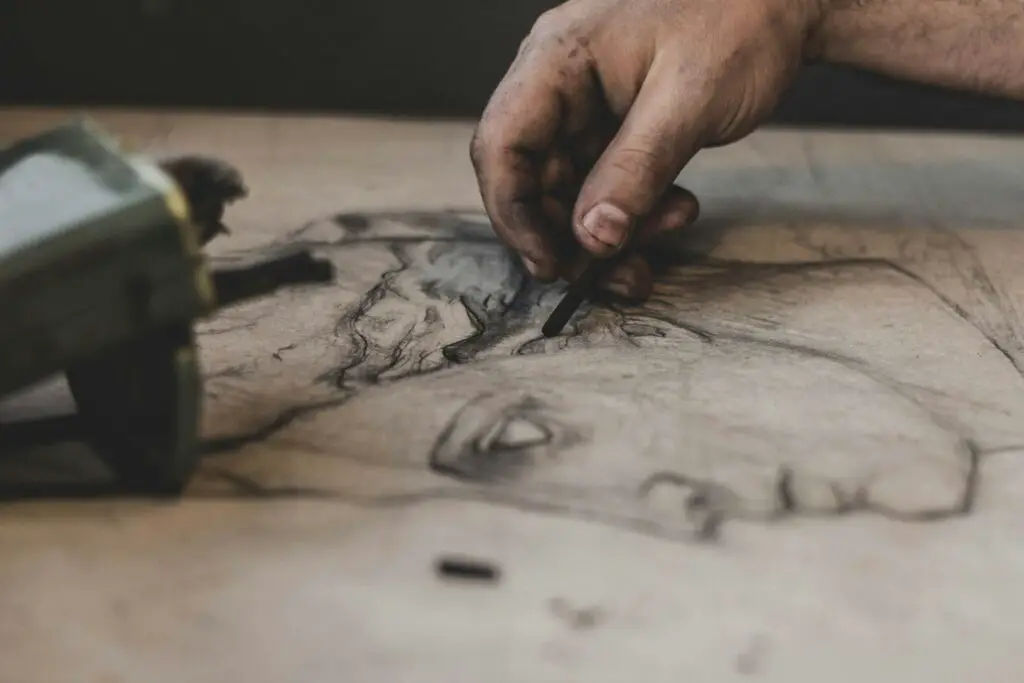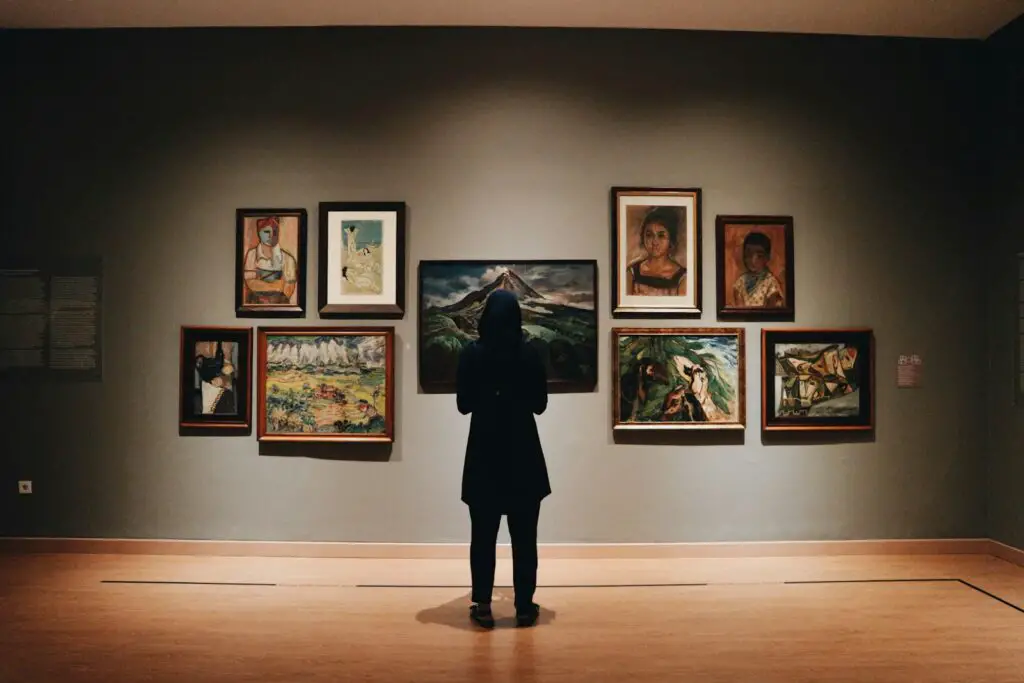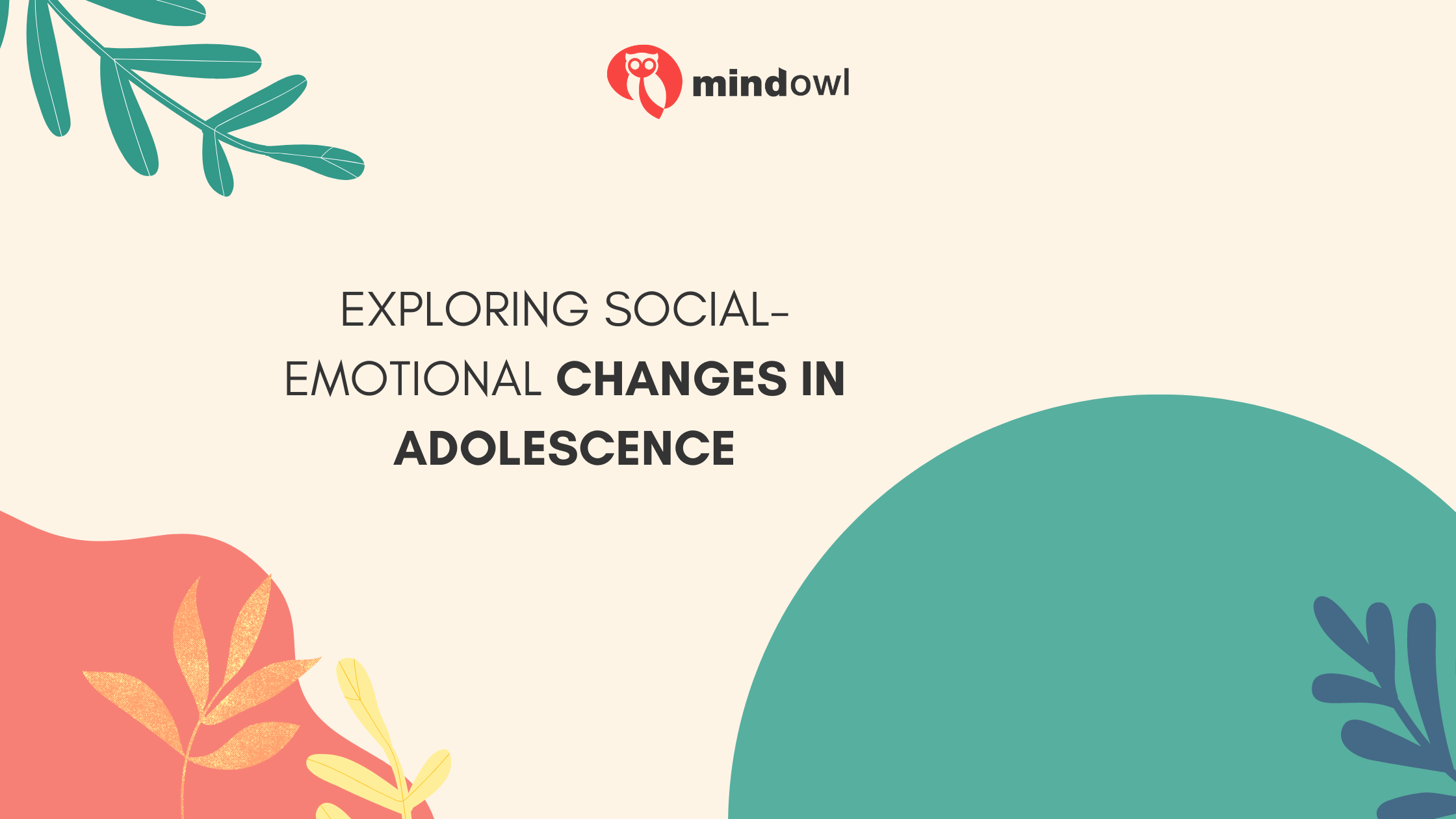While mindfulness and art are distinct, they share a deep connection that fosters personal growth and well-being.
Rooted in ancient traditions, mindfulness focuses on present-moment awareness and non-judgmental observation of thoughts and emotions. Art, as a form of self-expression, allows for creativity and emotional release.
When combined, mindful art encourages full engagement in the creative process, promoting stress reduction and self-acceptance. Similarly, art can serve as a gateway to mindfulness, inviting individuals to slow down and appreciate the present moment.
This article explores the synergies between mindfulness and art, highlighting their benefits and transformative potential.
Key Takeaways
- Mindfulness-Based Art Therapy (MBAT) blends mindfulness and art therapy to improve mental health.
- Engaging in art activities mindfully, like mindful art journaling or observing artwork without judgment, boosts creativity, focus, and emotional regulation.
- Practising mindfulness in a museum enhances appreciation of art by deepening the connection with the artworks observed.
What is Mindfulness-Based Art Therapy (MBAT)?
Definition of MBAT
MBAT stands for Mindfulness-Based Art Therapy. This approach blends mindfulness practices, like meditation and yoga, with art therapy. It aims to lower stress levels and boost well-being.
Therapists use this mix to help people find healthier ways to handle their feelings.
In MBAT sessions, therapists guide through mindfulness teachings, meditations, and art creation. People learn to become aware of their sensations without judgment. This helps in coping better emotionally and psychologically.
The practice involves various art materials to express oneself creatively while focusing on the present moment.
Benefits of MBAT
Mindfulness-Based Art Therapy (MBAT) combines the calming practice of mindfulness with the creative process of art-making. This powerful blend offers a unique pathway to wellness and self-discovery. Here are some key benefits:
- Boosts Self-Awareness: MBAT encourages you to focus on the present moment, helping you become more aware of your thoughts, feelings, and body sensations.
- Increases Resilience: Through creating art mindfully, individuals learn to face challenges with a fresh perspective, building their inner strength.
- Enhances Self-Compassion: As people notice their breath and immerse themselves in the creative process without judgement, they often find kindness for themselves.
- Relieves Symptoms of Anxiety and Depression: Engaging in MBAT has shown to reduce feelings of sadness and worry, making daily life feel more manageable.
- Improves Physical Well-being: Participants have reported less physical distress after spending time in mindful art activities, experiencing relief from fatigue and improved physical function.
- Reduces Stress Levels: The meditative aspect of MBAT can help calm the nervous system, leading to lower stress levels and a sense of peace.
- Boosts Focus and Concentration: Mindfulness meditation within art therapy helps clear the mind, improving attention span and concentration.
- Fosters Emotional Regulation: Creating art mindfully allows for healthy expression and management of emotions, helping regulate negative emotional responses.
- Encourages Non-Judgemental Attitude: Engaging in art-making with an openness lets individuals approach situations in life with less criticism towards themselves and others.
- Promotes Creative Thinking: MBAT unlocks creativity, inviting new ways of thinking that can be applied beyond the therapy session into personal or professional challenges.
- Enhances Social Skills: Group settings provide a space for shared artistic experiences, promoting understanding and empathy among participants.
- Improves Mood: The dual focus on mindfulness meditation exercises combined with expressing oneself through art forms lifts spirits and can lead to positive mood changes over time.
- Builds Healthy Habits: Regularly practicing mindfulness through artistic creation encourages habits that contribute to overall mental health maintenance.
Exploring the Intersection of Mindfulness and Art Therapy
Understanding mindfulness
Mindfulness means paying full attention to the present moment. It involves noticing your thoughts, feelings, and physical sensations without judgment. This practice helps you become more aware of what’s happening around and inside you.
Mindfulness allows for a pause before reacting, giving space to choose how to act. Many people find this helps them deal with negative emotions in a healthier way.
Mindfulness is the practice of being fully engaged in the present moment, using techniques like meditation and deep breathing.
When making art, mindfulness comes into play through focusing on things like texture and color. This focus can quiet the mind and spark creativity. Art therapy uses these principles to help people explore their emotions, often leading to emotional and psychological healing.
Practicing mindfulness through art invites curiosity and self-expression, laying a foundation for improved self-esteem and mental health.
Understanding art therapy
Art therapy uses art to help people express their feelings and improve their mental health. It combines the world of creativity with psychology, aiding folks in exploring their inner selves.
Through creating art, individuals can share what’s on their minds without having to find the perfect words. This approach supports them in becoming more comfortable with themselves and others.
This form of therapy offers a unique way for people to work through issues by externalising emotions onto a creative canvas—be it through painting, drawing, or collage making. Engaging in such activities allows participants to meditate on their feelings and notice changes within themselves over time.
Art acts as an invitation for self-discovery and helps reset one’s mind amidst chaos or stress around us.
Benefits of combining mindfulness and art therapy
Combining mindfulness and art therapy offers a powerful way to improve mental health. This approach helps individuals explore emotions and foster creativity for healing. Here are the benefits:
- Boosts mental well-being: Mindfulness-based art therapy (MBAT) tackles psychological issues effectively. It helps people feel more relaxed and positive.
- Enhances self-awareness: Engaging in creative work allows individuals to express themselves without words. They learn about their thoughts and feelings in a meaningful way.
- Supports creativity: Mindfulness practices, like noticing your breath, prepare the mind for creative endeavours. Art then becomes a natural outlet for these energies.
- Reduces stress: The act of creating art can be a form of meditation. This process, combined with mindfulness techniques, significantly lowers stress levels.
- Improves focus: Participating in present-moment art-making activities sharpens concentration. Individuals become better at focusing on tasks in other areas of life too.
- Encourages emotional healing: Through art, people can process complex emotions safely. Mindfulness adds an element of kindness and non-judgement to this exploration.
- Strengthens the brain: Deep breathing and calm thoughts change brain functioning over time. These changes support healthier thought patterns.
- Allows for physical symptom relief: The combination often leads to improvements in physical ailments related to stress and anxiety.
- Enhances appreciation for art: Practicing mindfulness while engaging with art deepens one’s connection to the piece, making experiences more vivid.
- Opens new perspectives: Creating art mindfully helps people see problems in new ways, leading to innovative solutions.
- Encourages present moment living: Both practices teach the value of living in the now, reducing worries about the past or future.
- Facilitates community building: Sharing mindful art experiences with others can create bonds based on mutual understanding and empathy.
Engaging in MBAT might also help those looking to integrate these practices into daily life find a supportive path toward overall wellness – proving it’s not just an activity but a lifestyle choice that fosters ongoing personal development and growth.

Creative Art Activities for Mindful Practice
Mindful art journaling
Mindful art journaling is a powerful practice that turns self-doubt into creative expression. It involves nine steps to unlock your creativity. This method helps you notice your breath and feelings, letting them inspire your artwork.
You don’t just create; you listen to what’s happening inside you. The Mindful Art Therapy Workbook guides through this process with art prompts and mindfulness exercises.
Art allows us to find ourselves and lose ourselves at the same time.
This workbook acts as a prompt, encouraging all to take time and explore their thoughts through colors and shapes on paper. Engaging in this activity might make anyone feel more comfortable with their inner critic, turning harsh thoughts into something beautiful.
It teaches how to be present without judgment, making every stroke of paint or scribble meaningful.
Using art to tap into creativity and trust
Art practice brings present-moment awareness alive, unlocking creativity. This approach allows you to meet your inner critic head-on. You learn to trust the process and be in the moment without passing judgment.
Think of it as engaging with a work of art – every stroke tells a story, guiding you deeper into trust and creative freedom.
Engaging in art activities like drawing or sculpting with mindfulness at heart fosters an environment where trust flourishes. You’re not just looking at the painting; you are part of its creation, letting intuition guide each decision.
This builds confidence not only in art making but also in life choices, teaching valuable lessons about trusting oneself and others.
Engaging in present-moment art-making without judgement
Art-making in the present moment can help ground us. No need for self-criticism or assessment when creating art – just let it flow freely.
Escape into the act of painting, sketching, or sculpting without worrying about criticism. Open yourself to the experience and let creativity guide your hand.
Mindfulness plays a crucial role in how we experience art. When we practice mindfulness, it helps us to fully engage with the artwork, allowing us to observe and appreciate the details and emotions it evokes.
By being mindful, we can immerse ourselves in the present moment and connect more deeply with the artistic expression before us, enhancing our overall experience of art.
Practising mindfulness in experiencing art allows for a deeper understanding of the artwork’s impact on our thoughts and emotions. This level of awareness enables us to tap into our creativity and explore different perspectives within the art piece itself.
Ultimately, incorporating mindfulness into observing art enriches our connection to the artwork and enhances its ability to evoke powerful feelings and insights within us.
Mindfulness Practice in the Museum
Practicing mindfulness in a museum setting
Practising mindfulness in a museum setting can lead to deeper connections with art and the present moment. It encourages focused observation of artwork, which in turn nurtures awareness and relaxation.
Engaging in mindful viewing helps individuals connect with their surroundings and experiences, fostering a sense of calm and tranquillity. Moreover, it offers an opportunity to appreciate art on a more profound level while also promoting mental well-being.
Immersing oneself in the museum environment fosters mindfulness by encouraging deliberate attention to visual stimuli, strengthening focus and enhancing engagement with the artistic displays.
By integrating mindfulness into the museum experience, visitors can benefit from heightened sensory perception, improved emotional regulation, and enhanced overall appreciation for art while being fully present in each moment.

Benefits of practicing mindfulness in the museum
Practicing mindfulness in the museum offers numerous benefits:
- Enhances appreciation and connection with art, fostering a deeper understanding of cultural and historical significance.
- Promotes mental well-being by reducing stress and anxiety, creating a tranquil environment for self-reflection and relaxation.
- Cultivates a sense of mindfulness, allowing visitors to engage with art on a deeper, more meaningful level.
- Leads to an expanded perspective and heightened creativity, encouraging new insights and innovative thinking.
- Nourishes the mind, body, and spirit by providing a serene space for contemplation amidst inspiring artworks.
These advantages demonstrate how mindfulness practice in the museum enriches the overall experience and promotes holistic well-being.
Incorporating mindfulness into art therapy sessions
Mindfulness can be integrated into art therapy by encouraging clients to focus on the present moment during artistic expression. This process can help develop a sense of calm and relaxation, reducing stress and anxiety.
Mindful art journaling, for example, allows individuals to express their emotions through creativity while staying present in the moment. Engaging in art-making without judgment promotes self-compassion and acceptance, contributing to improved mental well-being.
By incorporating mindfulness practices such as deep breathing and awareness of sensations into art therapy sessions, individuals may experience enhanced emotional regulation and a deeper connection with their creative process.
Incorporating mindfulness into art therapy supports the development of essential coping skills and fosters self-awareness through engaging in non-judgmental artistic activities. The combination offers a holistic approach that addresses psychological issues while promoting relaxation and emotional exploration within a safe framework inspired by mindful practices.
The Future of Mindfulness in Art Therapy
Mindfulness holds the potential to further influence art therapy. Integrating mindfulness into art therapy sessions can help enhance mental health benefits for individuals. By incorporating techniques like mindful breathing and present-moment awareness, art therapists can create a more holistic approach to addressing emotional and psychological well-being within their practice.
The continued exploration of how mindfulness can elevate the field of art therapy offers promising opportunities for supporting individuals in managing stress, tapping into creativity, and exploring their emotions through artistic expression.
Additionally, the integration of mindfulness practices within the realm of art therapy presents an avenue for deepening self-awareness and promoting relaxation. This fusion also aligns with research demonstrating that engaging in creative activities while maintaining a mindful presence can positively impact overall well-being by reducing stress levels and fostering a greater sense of calmness and resilience.
By embracing mindfulness as an integral component of art therapy interventions, practitioners have the potential to further enrich their therapeutic approaches and offer more comprehensive support to clients seeking avenues for self-expression, healing, and personal growth.
Potential for greater mental health benefits through mindfulness-based art therapy
By incorporating mindfulness into art therapy sessions, individuals may experience greater mental health benefits. Mindfulness-based art therapy has been shown to enhance mindfulness and partially mediate the association between increased daily spiritual experiences and improved mental health-related outcomes.
Through creative activities like mindful art journaling, using art to tap into creativity and trust, and engaging in present-moment art-making without judgment, individuals can develop a sense of solace and emotional well-being.
This intersection of mindfulness and art therapy provides a unique opportunity for individuals to unleash their creativity while also fostering a sense of peace and calmness through the therapeutic process.
Furthermore, by practicing mindfulness in the museum setting, individuals have the opportunity to explore further avenues for holistic well-being. The role of mindfulness in experiencing artwork can provide a refreshing perspective on one’s thoughts and emotions.
By combining contemplative practices with artistic exploration, people may find themselves better equipped to cope with anxiety or stress related to everyday challenges.
Conclusion
In conclusion, the intersection of mindfulness and art therapy offers creative activities for a mindful practice that can enhance self-awareness, emotional exploration, and psychological well-being.
Incorporating art with mindfulness can promote relaxation, stress reduction, and support creativity. The combination of mindfulness practices with art-making presents an innovative approach to explore emotions and foster self-actualisation.
Practising mindfulness in a museum setting also provides unique benefits for experiencing art. As mindfulness continues to shape the field of art therapy, there is potential for greater mental health benefits through these combined practices.
FAQs
1. What are the benefits of mindfulness-based art therapy?
Mindfulness-based art therapy can feel like taking a peaceful walk through your mind while playing with colours and shapes – it can ease physical symptoms brought on by stress, such as tension headaches or stomachaches.
2. Can looking at paintings be part of art therapy?
When you look at a painting as part of this therapy, it’s not just about what you see; it’s about experiencing the present moment without judgment.
3. Is mindfulness-based art therapy suitable for everyone?
Yes, whether you’re an experienced artist or someone who hasn’t picked up a paintbrush since school day It’s all about exploring your thoughts and emotions creatively, making it ideal for anyone willing to give it a try.
MindOwl Founder – My own struggles in life have led me to this path of understanding the human condition. I graduated with a bachelor’s degree in philosophy before completing a master’s degree in psychology at Regent’s University London. I then completed a postgraduate diploma in philosophical counselling before being trained in ACT (Acceptance and commitment therapy).
I’ve spent the last eight years studying the encounter of meditative practices with modern psychology.

